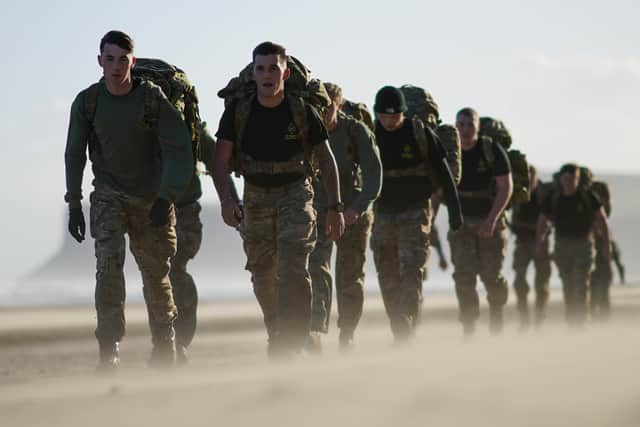Conscription: will it return in the event of war or WW3, UK army ages, meaning, what is it - WW2 conscription
and live on Freeview channel 276
The head of the British Army is set to warn the public that they may be summoned to serve in defence of King and country should a conflict with Russia arise, saying that the military's current size is inadequate to handle such a confrontation..
General Sir Patrick Sanders, Chief of the General Staff, will underscore the necessity for government officials to "mobilise the nation" and reintroduce conscription in the event of a broader conflict with Russia amid its ongoing invasion of Ukraine.
Advertisement
Hide AdAdvertisement
Hide AdHis warning follows a statement made nearly two years ago, in which he described Britain's situation as its "1937 moment," alluding to the critical period leading up to the outbreak of the Second World War.
Gen Sir Patrick, who has been vocal about staffing deficiencies within the military, says there should be a fundamental "shift" in the public's mindset, and believes that citizens should be prepared to defend the UK against external threats.
Conscription has not been implemented in the UK since the conclusion of National Service in 1960. Here is everything you need to know about it.
How often has conscription been in place?
Conscription has been implemented at various points in British history, with its most significant periods during the two World Wars.
Advertisement
Hide AdAdvertisement
Hide AdThe First World War marked a turning point in the British approach to conscription, and prior to the conflict, the UK relied on a volunteer army.
But as the war progressed and the demand for manpower increased, it became evident that voluntary recruitment was insufficient. In 1916, the British government passed the Military Service Act, introducing conscription for the first time in the country's history.
The act initially applied to unmarried men between the ages of 18 and 41, but was later expanded to include married men.
The move was met with mixed reactions, with some segments of society supporting the measure as a patriotic duty, while others opposed it on grounds of personal freedom.
Advertisement
Hide AdAdvertisement
Hide Ad

After the conclusion of World War I, conscription was temporarily suspended, but it returned in the lead-up to World War II.
In 1939, with the outbreak of hostilities, the National Service (Armed Forces) Act was enacted, once again mandating conscription. This time, it applied to all able-bodied men between the ages of 18 and 41.
Following World War II, conscription continued for a period known as National Service, which lasted from 1947 to 1960.
How many people were conscripted in the World Wars?
During the First World War, approximately 2.5 million men were conscripted into the British armed forces. Conscription was essential for maintaining the necessary military strength to confront the challenges of the global conflict.
Advertisement
Hide AdAdvertisement
Hide AdThe scale of conscription during World War II was even more substantial than in the previous conflict. By the war's end in 1945, over 5.7 million men had been conscripted into the British armed forces.
The demands of total war required a massive mobilisation of manpower, and conscription played a pivotal role in ensuring the necessary numbers for military operations on various fronts.
The introduction of conscription during both World Wars underscored the government's recognition of the need for a broader and more inclusive approach to national defence. It also reflected the shifting societal attitudes toward military service and the understanding that the entire nation had a role to play in times of conflict.
What was National Service?
After the conclusion of World War II, the practice of conscription persisted under the term National Service, spanning the years from 1947 to 1960.
Advertisement
Hide AdAdvertisement
Hide AdDuring this time, all British men between the ages of 18 and 30 were required to serve in the armed forces for 18 months, with an additional four years in the reserves.
National Service aimed to maintain a sufficient military deterrent in the post-war era, given the geopolitical uncertainties of the time, particularly the emerging Cold War.
Approximately 2.3 million men underwent National Service during the 1950s. The program involved a diverse range of roles within the armed forces, including the army, navy and air force.
National Service was a transformative experience for many individuals, exposing them to military discipline, teamwork and a sense of duty. While some viewed it as an unwelcome obligation, others found it to be a valuable and character-building period in their lives.
Advertisement
Hide AdAdvertisement
Hide AdThe end of National Service in 1960 marked a shift in the UK's military recruitment strategy. The evolving nature of warfare and the changing geopolitical landscape led to the establishment of a professional, volunteer-based armed forces.
Who could be affected if conscription does return?
If conscription were to return in the UK in modern times, a broad spectrum of the population could potentially be affected, though the impact would largely depend on the specific legislation and criteria set by the government for conscription.
Historically, conscription has primarily targeted individuals within a certain age range. Young adults, typically between the ages of 18 and 30, might be subject to conscription.
The UK's previous conscription policies have applied to men, but in modern times, and with other countries moving towards inclusive conscription policies that include both men and women, anybody could be called up, regardless of gender.
Comment Guidelines
National World encourages reader discussion on our stories. User feedback, insights and back-and-forth exchanges add a rich layer of context to reporting. Please review our Community Guidelines before commenting.
